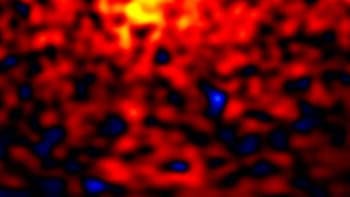The Spirit rover that landed on Mars early this year has revealed that volcanic activity may explain features previously thought to be due to water

As a young geologist, I remember sitting in the mission control room of NASA’s Jet Propulsion Laboratory with Carl Sagan in 1976, waiting for the first colour images of Mars from the Viking lander spacecraft to scroll down the television screen. I was glued to the emerging details of the rock colours but Carl, ever the cosmic observer, turned to me and said, “Jim, we have just confirmed one of the findings of Palaeolithic man: Mars is red!”. Despite this welcome confirmation, we soon became frustrated by the unchanging view provided by the stationary lander and our inability to glance over the Martian horizon.
In 1997, some 21 years after the Viking landings, Pathfinder touched down on Mars and the Sojourner rover excited millions of Web viewers with its ability to explore and respond to new information with daily commands from Earth. But this was only the third landing site on Mars, and the distance travelled by Sojourner was frustratingly short.
Enter the Mars rovers Spirit and Opportunity, which were successfully delivered to the red planet in January by NASA’s Mars Exploration Rover mission. Designed to explore over much longer distances and to carry many more instruments than before, these twin rovers are a geologist’s dream. Since they landed, there has been months of frenzied activity as the information that is sent back daily is analysed and digested, and new commands are sent to the planet’s surface. And after 90 Martian days of operation (1 Martian day equals 24 hours and 39 minutes), researchers on the Spirit team have reported the initial results of this fascinating journey of discovery in a series of 11 papers (Science 305 794-845).
Global view
On Earth, geologists begin their analyses with the small, looking at one rock exposure after another and slowly building up a picture of the processes that have shaped the planet during its long and complex history. For planetary geologists studying Mars, however, technology has dictated that this learning sequence is reversed. First we had fuzzy telescopic views, followed by global perspectives from orbiting spacecraft and, finally, spacecraft that could descend onto the surface to perform the vital close-up work.
Our view of Mars from the various orbiting missions and analyses of Martian meteorites is one of a cold, dry desert that was once warmer and wetter, and that may even have harboured life (see Physics World January 2003 pp35-40). To find out what Mars was like back then, how its climate changed so drastically, and to look for the candidate abodes for primitive life, researchers chose to explore Mars by “following the water”. As a result, the landing site chosen for the Spirit rover was an ancient impact crater named Gusev, which has river-like channels entering and leaving it, and a smooth floor thought to be paved with ancient sedimentary rocks. This makes it a good place to examine the deposits of ancient rivers and lakes, and, perhaps, even find fossils.
Armed with sophisticated instruments to probe the characteristics of the local rocks and soils it encountered, Spirit also has a variety of multiwavelength cameras to put these results into the context of its surroundings. What has begun to emerge in the Martian soil is a true discovery, not just a simple confirmation of previous ideas.
Soils are loose surface materials that originate from wind-blown material from other regions, or from chemical weathering of the underlying bedrock. Understanding the nature of this underlying bedrock is fundamentally important because it tells you about the local subsurface composition. After examining the adjacent soil and fully documenting its surroundings with panoramic images, Spirit left its landing site – which is named the Columbia Memorial Station – and headed for a nearby large rock.
Like explorers throughout history, the intrepid Spirit team led by Steven Squyres of Cornell University began to apply informal names to the rocks and features they encountered. The first stop was a mountainous boulder called Adirondack, followed by a sprint to a small crater-like depression called the Laguna Hollow, where Spirit dug a small trench. Next, the solar-powered rover investigated the rim and floor of another crater known as Bonneville, before finally traversing in the direction of the “Columbia Hills” some 2.6 km southeast of the landing site, with a stop along the way to examine a light-toned rock dubbed Mazatzal. So far, Spirit has covered over 600 m, and it continues to rove.
Rocky surprise
Throughout the region explored, Spirit found soil that was similar in composition to that seen by the Viking and Pathfinder missions. The ubiquitous soil is dominated by basalt, which is a rock type indicative of volcanic lava flows and not ancient lake sediments. But the soil also appears to contain tantalizing enhancements of sulphur and chlorine together with evidence of minor amounts of sulphates and carbonates. All of these are consistent with the ancient presence of water. As if to verify the prescient imagination of science-fiction writer Frank Herbert, numerous ripples and drifts of dust and sand dotted the landscape.
The rocky landscape offers many opportunities to visit individual rocks, which have been mostly excavated by countless meteorite impacts and strewn around the craters. Most of the rocks are coated with bright materials and have been eroded and shaped by the incessant Martian winds. Adirondack, for example, stuck out because of its size and its two-toned appearance, which is reminiscent of a 1950s automobile. The upper part has a fresh and dark-appearing tone, while the lower part is paler and coated, indicating that some of the surrounding soil has been removed by wind.
Anticipating such rock coatings from the earlier Viking and Pathfinder missions, engineers had designed a rock-abrasion tool to penetrate through the coatings and investigate the composition of the solid rock. Adirondack provided the first surprise: the local rocks were not, in fact, sediments from an ancient lake, but volcanic rocks of basaltic composition analogous to lava flows on, for example, Hawaii. This finding was later confirmed by analyses of other rocks along the journey.
So where were the anticipated sedimentary deposits? Impact craters provide natural drill-holes into planetary surfaces, and Spirit explored several of these in order to examine materials brought up from shallow depths below the surface. But here too, there appeared to be nothing but volcanic rocks.
The summary of the mission findings to date suggest that the geological history of the Gusev crater floor explored by Spirit is dominated by three processes. The first is the volcanic extrusion of lava flows, which cooled and hardened to create a region of smooth, dark plains. The second is the subsequent cratering events, which disrupted and excavated portions of the underlying lava-flow bedrock. Finally, wind-related abrasion modified the surface and ejected impact blocks, and also deposited dust from distant sources. Although coatings and veins that may have resulted from reactions with aqueous fluids were found, no evidence for ancient lake deposits was revealed.
These unexpected results are the true rewards of exploration. As the late planetary scientist Tom McGetchin used to say, the geological processes that were thought to have shaped Mars turned out not to be option a, b or c, but option d – “none of the above”. These results provide important confirmation that areas showing evidence of water erosion have also been heavily influenced by lavas. Furthermore, they have prompted significant rethinking in the research community.
Some researchers now think that many of the channels extending into and out of ancient craters could be caused by lava flows, not water erosion. Others believe that the lava flows on this part of the Gusev crater floor are simply a surface coating on ancient lake deposits, some of which may be exposed at the Columbia Hills. Still others believe that the evidence for ancient flowing water is overwhelmingly demonstrated by ever-higher-resolution views of the surface from orbit, including strong evidence for river channels and Mississippi-like sedimentary deltas.
Spirit’s twin spacecraft, Opportunity, is searching for evidence of ancient water in a totally different geological environment. Preliminary findings include evidence of rock layering, which could be the result of running water, and several minerals have been discovered that might have formed due to the action of Martian groundwater. We now anxiously await the first official reports from the Opportunity team.



